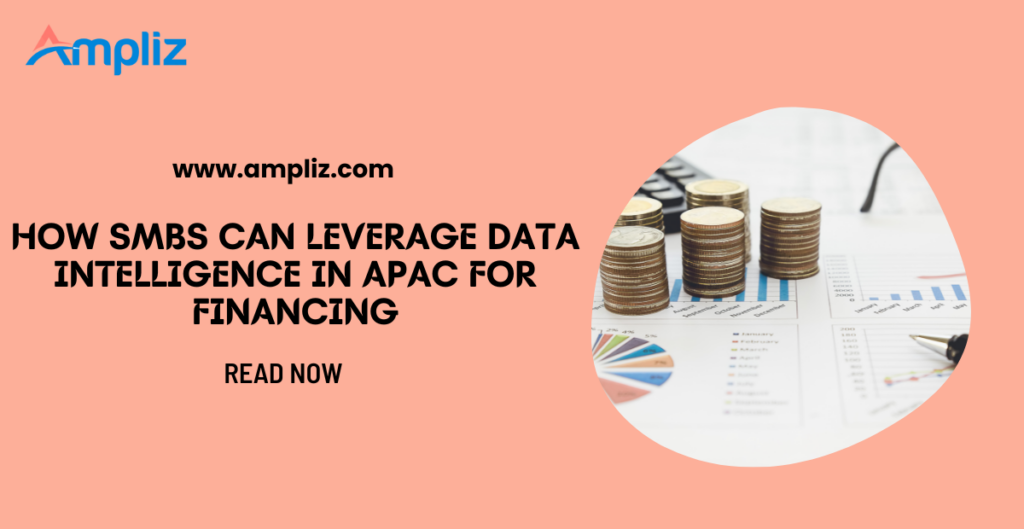The APAC region is an economic powerhouse, growing 4.5% in 2023 and accounting for almost half of the whole planet’s GDP.
While a multitude of well-known multinationals hail from this part of the world, small and medium-sized businesses are commonplace here. And like any other type of enterprise, they need access to funding in order to grow.
Thankfully the emergence of data intelligence tools and techniques creates a number of opportunities for innovative approaches to SMB financing. Here’s a look at how this can be harnessed by APAC-based organizations that are compact yet ambitious.
Harnessing big data analytics to build credit profiles
More than 330 million small enterprises exist today, and the majority are based in Asia. Yet small to medium-sized businesses (SMBs) in the APAC region face unique financing challenges.
Traditional credit profiles often fail to capture the nuanced financial behaviors of these enterprises. Luckily, leveraging big data analytics lets SMBs paint a clearer picture of their creditworthiness.
Understanding data sources
To build robust credit profiles, SMBs need diverse and accurate data sources:
- Transactional Data: Monitor sales transactions and cash flows.
- Customer Payment Histories: Track consistency and timeliness of customer payments.
- Supply Chain Information: Evaluate supplier reliability and associated costs.
Big data analytics tools help aggregate this information seamlessly. They transform raw data into actionable insights.
Predictive analytics for credit scoring
Advanced algorithms predict future financial behavior by analyzing historical patterns. This helps in creating dynamic credit scores that reflect real-time business conditions:
- Predictive models identify potential default risks before they materialize.
- Continuous updates ensure credit profiles remain current with minimal manual intervention.
These techniques reduce reliance on static metrics like traditional bank statements or fixed-period revenue reports.
Enhancing transparency with blockchain
Blockchain-based solutions are already a multi-billion dollar market, with continued growth leading them to top $1 trillion within five years. From a financing perspective, this technology enhances transparency in transactions:
- Immutable ledgers record every transaction securely.
- Financial institutions gain trust through tamper-proof records.
Basically, blockchain provides an environment where lenders have more confidence in the integrity of reported financial activities.
So for instance, let’s say an emerging retail company in Singapore starts using these methods. It integrates various payment platforms’ transactional data through big data platforms, boosting its credibility among lenders despite being relatively new. Then when applying for loans, it is far more likely to get approved.
In short, focusing on comprehensive datasets, predictive analytics, and blockchain security measures means SMBs present stronger cases for financing opportunities. Advanced tools simplify traditionally complex processes while improving accuracy, both of which are fundamental for funding growth effectively.
Accessing local funding sources with data-driven insights
Investment in APAC businesses actually dropped last year, dipping 36% in the first 6 months and struggling afterwards. This exemplifies the struggle that SMBs face in their efforts to expand. Using data-driven insights, they can effectively tap into local funding sources, rather than finding them a tough nut to crack.
Understanding market dynamics
First, it’s wise to analyze local market conditions. Real-time data allows SMBs to understand trends and make informed decisions about where and when to seek funding.
- Local economic indicators: Keep track of GDP growth rates, inflation, and other macroeconomic factors. For instance, India is expected to grow its GDP by 6% in 2024, while Japan is falling below 1%.
- Industry-specific trends: Use sector reports to gauge industry health and investor interest. Take the chemicals sector, which is set to expand by 5.4% this year – well above the global average.
Identifying suitable funding options
Different types of funding sources cater to varying business needs. Utilize data intelligence tools for a comprehensive overview:
- Government grants and subsidies: Research available programs tailored for small businesses. For instance, Australia has recently announced a new set of grants worth up to $5 million which target fast-growing SMEs.
- Microfinance institutions: Look into lenders focused on providing smaller loan amounts at competitive rates.
Building credibility with lenders
You need to leverage financial documentation bolstered by accurate data analysis. To do this:
- Prepare detailed financial statements showcasing consistent revenue growth.
- Use predictive models to forecast future earnings accurately.
- Highlight key performance metrics that resonate with lenders’ criteria.
A well-documented credit profile increases the chances of securing favorable terms from local financiers, as touched on earlier.
Case study: Singapore’s SME Go Digital program
Singapore exemplifies effective use of data-driven insights in accessing local funding. The authorities are especially eager to support SMEs since they make up 50% of its GDP. This program assists them in adopting digital technologies, backed by comprehensive governmental support. Participating businesses have seen improved efficiency, higher revenue streams, and better access to finance due to their enhanced digital profiles.
Essentially, strategies grounded in data intelligence make local funding less elusive for SMBs in APAC. Furthermore, they can be applied in any other global region with only minor tweaks.
Navigating international financing opportunities using big data
International financing can unlock significant growth opportunities for SMBs in the APAC region. Leveraging big data provides these businesses with the tools needed to navigate global funding landscapes effectively.
Global Market Analysis
Utilizing big data allows SMBs to conduct comprehensive market analyses:
- Cross-border economic trends: Identify stable markets by analyzing macroeconomic indicators. The IMF’s regular stability reports are useful for this. The latest found that there was a 12.5% drop in commercial real estate prices, which might alter funding decisions, for instance.
- Regulatory environments: Understand compliance requirements in target countries. GDPR’s role in regulating European business operations regarding data privacy is a good example of this. Since 46% of compliance professionals expect the amount of regulatory info to rise in the next year, complacency is not an option.
- Competitor benchmarking: Compare performance metrics against international competitors.
These insights help pinpoint viable financing sources and reduce risks associated with foreign investments.
Understanding financing instruments
Different international markets offer varied financial instruments. Here’s how big data aids in making informed choices:
- Export credit agencies (ECAs): Analyze support programs provided by ECAs for overseas expansion.
- International venture capital: Leverage datasets on investor behavior and preferences.
- Foreign bank loans: Evaluate lending conditions using historical interest rate trends and currency stability indices.
SMBs must also familiarize themselves with specific loan programs in other nations. For instance, understanding the SBA 7(a) loan as it applies to small companies based in the US is useful in this context. It caters to businesses looking for flexible terms abroad, although it has strict eligibility requirements.
Enhancing financial documentation standards
Financial transparency is crucial when dealing with international financiers. Use big data to enhance documentation practices:
- Implement real-time accounting systems that provide accurate, up-to-date financial records.
- Develop comprehensive business plans supported by predictive analytics models demonstrating projected growth trajectories.
Case study: Japanese SMEs entering European markets
There is a strong link between Japan and the EU, with the Economic Partnership implemented in 2019 helping strengthen existing bonds. In turn, Japanese small businesses have successfully leveraged big data to enter European markets.
For instance, analyzing consumption patterns and regulatory frameworks across Europe means these companies can tailor their products better and comply seamlessly with local laws. Their improved understanding of customer behaviors and legal standards significantly enhances their appeal to European investors, leading them into successful financing agreements overseas.
Take the grocery market as an example, which was up by 8.6% last year, and underwent a 12.8% spike in pricing. Data shows that The Netherlands is the biggest market for Japanese food brands, which can in turn inform export decisions. And when it comes to courting foreign investment, this is also immensely useful information.
What we’ve shown is that using these strategies grounded in robust data intelligence empowers APAC SMBs. They can both secure necessary funds and also strategically position themselves within global marketplaces for sustained success. It just takes the gumption of decision-makers to spread their wings and soar towards overseas opportunities.
Real-time data integration for informed financial decisions
Integrating real-time data can significantly elevate how SMBs in the APAC region make financial decisions. This proactive approach ensures businesses stay agile, responding quickly to market changes and optimizing their funding strategies.
Benefits of real-time data
Incorporating real-time data into financial operations provides several key benefits:
- Immediate insights: Gain instant visibility into financial health.
- Timely adjustments: Make swift strategic shifts based on current data.
- Enhanced forecasting: Improve accuracy with up-to-date information.
These advantages collectively enhance decision-making capabilities, leading to more informed and effective actions.
Implementing real-time systems
To harness the power of real-time data, SMBs must adopt appropriate technologies:
- Cloud-based accounting software: Platforms like Xero or QuickBooks offer live updates on transactions and balances.
- Integrated ERP systems: Enterprise Resource Planning tools centralize business processes, providing a cohesive view of finances across departments.
- IoT devices for inventory management: Internet of Things technology tracks stock levels in real time, feeding directly into financial models.
These tools streamline data collection and analysis, ensuring all information remains current and accurate.
Utilizing predictive models
Real-time integration enhances predictive modeling efforts by constantly refreshing input variables:
- Use machine learning algorithms that adapt dynamically as new data comes in.
- Develop scenario analysis considering various potential future events impacting cash flow or revenue streams.
For instance, an unexpected surge in demand can be swiftly factored into sales projections, allowing for immediate resource allocation adjustments.
Case study: Australian retailers optimizing CX
In Australia, 72% of retailers use data analytics to improve the custom experience and make the supply chain geared towards their needs. In this context, IoT-enabled inventory tracking combined with cloud-based ERP software is key.
These systems provide instantaneous updates on stock levels across multiple locations. With this constant stream of accurate inventory data integrated into their financing models, it’s possible to optimize loan applications based on actual needs rather than estimates. This allows for better terms to be offered by lenders due the reduced perceived risk and enhanced transparency.
Embracing these advanced technologies means SMBs throughout APAC can significantly improve their ability to manage finances strategically. In turn, they will ensure long term success, whatever hiccups might arise.
Emerging trends in AI and machine learning for SMB financing
Artificial intelligence (AI) and machine learning (ML) are revolutionizing how SMBs in the APAC region approach financing. These technologies offer new ways to assess creditworthiness, predict financial outcomes, and optimize funding strategies.
This should not be surprising given that 62% of APAC professionals are already up to speed with the advantages of AI. Moreover, 43% have adopted generative solutions for work, according to Deloitte. So it follows that financing is also set to be shaped by this tech.
AI-powered credit assessments
AI enhances traditional credit assessment methods by analyzing vast amounts of data quickly:
- Alternative data sources: Evaluate social media activity, payment histories, and even utility bill payments.
- Behavioral analytics: Understand spending patterns to predict future financial behaviors.
This comprehensive analysis allows lenders to make more informed decisions about lending terms, often benefiting SMBs with previously limited credit histories.
Predictive financial analytics
Machine learning models can forecast financial trends with high accuracy:
- Sales projections: Analyze historical sales data alongside current market conditions.
- Cash flow predictions: Use real-time inputs from accounting software to anticipate cash shortages or surpluses.
- Risk assessments: Continuously monitor potential risks based on dynamic market changes.
These predictive insights enable businesses to plan strategically rather than reactively.
Automating documentation processes
AI streamlines the creation and management of financial documents:
- Utilize natural language processing (NLP) tools for drafting detailed business plans or loan applications.
- Implement robotic process automation (RPA) for routine tasks like expense tracking or invoice generation.
Reducing manual efforts lets these tools deliver consistency while freeing up valuable time for strategic planning.
Case study: fintech adoption by Indian startups
Indian startups have increasingly turned towards fintech solutions powered by AI/ML. This is supported by the 87% adoption rate for fintech services in this country.
Many young companies employ automated bookkeeping systems that integrate seamlessly into their operations, generating real-time insights that are vital for maintaining liquidity. Such tools also help prepare tailored pitches for investors, employing ML driven algorithms to predict and showcase performance metrics.
All of this makes gauging investment readiness more accurate, thus enhancing their appeal, and affording increased funding success rates. The result is that more than $5.1 billion in funding has been raised in the past six months alone by Indian startups.
SMBs across the APAC region need to sit up and take notice of this reality. In doing so, they too can win over investors and grow rapidly.
Wrapping Up
As you can see, data intelligence has a huge influence over financing for APAC-based SMBs. Whether it’s in the form of credit building, funding application composition or compliance, big data analytics is involved.
Hopefully any small business decision-makers have been inspired to explore the potential this tech represents in their own industry and region. A cash injection is often the best catalyst for growth, and cutting edge tools can prime the syringe successfully.




